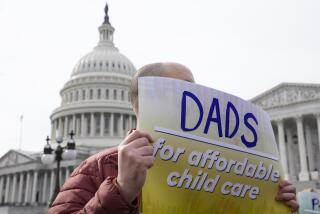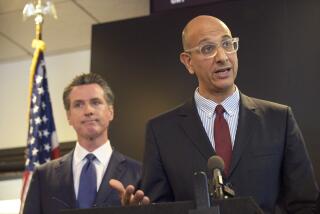Unresolved Questions on Child-Care Funds
- Share via
Like many day-care providers, Olivia Green has a wish list of ways she would use a few extra bucks: Money to buy the house next door to her Crenshaw district center and furnish it to accommodate the many children she has to turn away would be nice. New toys, fresh paint, and perhaps parenting classes for the overly stressed, generally impoverished mothers who make up her clientele wouldn’t hurt either.
So Green was excited when Gov. Pete Wilson this week proposed adding nearly $300 million to the state’s child-care system. But her excitement was tempered by questions of whether any of the money will trickle down to her small center that cares for nine at-risk youths.
“The issue of the money is great; Pete Wilson, I applaud you. But it’s not something you can give one big bunch of money [to] and that’s it. It has to continue,” said Green, who runs Families Working Together.
Child-care officials and advocates in Los Angeles County welcome the prospect of a new infusion of state money to expand child-care programs for the county’s poorest children. But there are no answers yet, they note, about who will administer the funds and how they will be used.
The governor’s proposed increase in funding comes as state legislators begin to consider one of the paramount concerns of new welfare policies mandating that more than 220,000 of the state’s aid recipients find work next year: what to do with the children.
The debate will spotlight a subsidized child-care system that is a chaotic patchwork of programs with different criteria for eligibility, different administrators, different levels of subsidy and even different waiting lists.
No one is quite sure, for example, how many children are eligible for subsidized care, how many are currently receiving subsidies or how many are waiting to get into programs.
The state Department of Education funds 16 different programs in Los Angeles County at a cost of $209 million to provide subsidized care to low-income families who do not qualify for welfare. The Department of Social Services administers seven programs of its own for families receiving public assistance, including those for GAIN participants, and for former welfare recipients terminated from aid because of excessive earnings.
California also receives federal child-care funding for Head Start programs.
But there is little coordination among the programs, even though authorities know that many families drift on and off welfare and need many of the same services.
It is a paradox of child care, for example, that as thousands of needy Los Angeles children wait for room in some centers, subsidized spaces in other high-quality centers go unfilled because they are too far away, too costly or do not offer specialized services, such as infant care. Equally frustrating for advocates is the failure of county welfare officials to adequately inform many poor families of the subsidies available to them.
By the county’s own estimate, only about 30% of the children on welfare who have been eligible for subsidized care currently receive it. Child-care advocates estimate that overall there are about 350,000 children in the county age 13 and under who live in poverty, making them eligible to apply for subsidized child care.
“The numbers are significantly smaller than one would expect for providing services countywide,” said Kathy Malaske-Samu, the county’s child-care coordinator. “But the Department of Public Social Services has a different attitude toward child care now than it has in past. They have recognized the relationship between child care and the parent’s ability to work. There is a new emphasis, spurred to some degree by welfare reform.”
If the Legislature approves Wilson’s proposal, Los Angeles County could be in line for about one-third of the $300 million, enough to provide subsidies for as many as 40,000 additional children.
Officials and advocates agree on the vital importance of subsidies: In Los Angeles County, the average pre-subsidy cost of full-time licensed care for a child under the age of 2 eats up 64% of minimum-wage earnings, according to providers. For a preschooler, 45% of minimum-wage earnings is typically spent on unsubsidized child care.
In many ways, the timing of the governor’s funding proposal could not have been better for Los Angeles County officials. Earlier this week, a county child-care advisory panel assisted by the Rand Corp. released a study that detailed many of the problems afflicting the system.
It has outlined an ambitious plan to revamp services: expanding facilities in communities that have been underserved; refocusing child development programs, including Head Start, to offer more specialized care; and training new child-care workers, many of whom are expected to be former welfare recipients.
*
But major questions about the proposed new funding stream remain. Among them:
* Who will administer the money? Wilson has targeted the vast majority of funds--$210 million--for social service departments that serve welfare recipients. Many advocates, however, support proposed legislation that would increase oversight by the Department of Education, where the priority would presumably be on child development.
Both providers and local officials want the money distributed evenly among all low-income clients.
“We have to be very careful when we start targeting the money toward any group because these are basically the same families,” Malaske-Samu said. “We have to be very careful as we structure the services that families teetering on the brink don’t fall over. A lot of the difference is availability of child care.”
* Is the proposed aid more than a one-shot deal and, if so, will future needs outstrip the available money? Providers fears that the proposed funding levels are not nearly high enough to meet the future demands anticipated under the federal welfare overhaul. The Rand report, for example, cautions that within two years, the cost of child care in the county could equal the governor’s proposed addition of $300 million statewide this year.
“It’s sort of the glass half-full or half-empty,” said Alice Walker Duff, executive director of Crystal Stairs in South Los Angeles, one of the largest child-care and development agencies in California. About 44% of their families are on Aid to Families With Dependent Children. “There’s supply and demand, and someone has to subsidize the demand for many, many families.”
* How will the money be used? Again, state officials have yet to determine what, if any, restrictions will be placed on the funds.
A spokeswoman for the State Department of Social Services said Wilson wants to give counties broad leeway to utilize the funds as they please, whether it is for expanding facilities, adding child-care workers, or providing vouchers for families to help pay for care.
Many providers, however, feel that parents should be required to place their children in licensed centers or family day-care homes, rather than leaving them with relatives or neighbors, as many programs now allow.
“That child is not receiving an early childhood education,” said Green. “It’s a rip-off. . . . I know too many people paying half the money and leaving the kid with whomever. So the baby sits up and watches TV all day, and we’re not talking ‘Sesame Street.’ ”
Green’s comments echo a debate that rages within the child-care community over the propriety of allowing subsidized care by nonprofessionals. Many providers cite studies that have shown such care to be less beneficial to children.
State and local officials say parents must be allowed the broadest array of options.
“It’s very hard because many people in many cultures feel much more comfortable having someone in the family take care of the children rather than a stranger,” said Vivian Weinsten, a member of the county’s Child Care Advisory Board and a member of the Rand study panel. The idea is not to get rid of that but to see if we can’t make people a little bit more willing to look at issues like health and safety.”
And Malaske-Samu said there are many structural barriers in the system that force families to choose less formal and inexpensive child care. Most welfare programs that provide subsidies require mothers to pay for child care upfront and later be reimbursed. Even the subsidy for care by relatives is not a direct payment but adjusted in the recipient’s grant.
*
Despite the myriad questions they have, local providers expressed guarded hope that the current debate will focus attention on the needs of real families and the county’s most vulnerable children.
In addition to expanding child-care slots, the new funds proposed by the governor might be used to help coordinate and streamline operations between the social services and education departments, they say.
“We are hopeful that some of this money can be utilized to acquire new spaces as well as rehabilitate and renovate existing ones,” said Mildred Lovett, program director for Second Baptist Children’s Center, which serves 98 children in South-Central Los Angeles whose parents are either working or in training. “What we have now is families that get a job on Monday and want child care on Tuesday. Unfortunately, a lot of programs cannot accommodate that. We’ve always had a waiting list, even before welfare reform started.”
More to Read
Sign up for Essential California
The most important California stories and recommendations in your inbox every morning.
You may occasionally receive promotional content from the Los Angeles Times.











